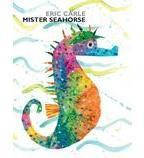Mister Seahorse

Scott O'Dell / 4-6 / Science /
Karana, an Indian girl, lives happily with her people on the Island of the Blue Dolphins.
It is an island in the Pacific that gets its name from its beautiful shape — from above it
looks like a dolphin lying on its side, "with its tail pointing toward sunrise," sunning itself
in the sea. Around it blue dolphins swim, otters play, and sea elephants and sea birds thrive.
Karana's people live in harmony among the other animals on and around the island as they
have for generations. Her father is the chief of the village. And then one day a boat comes
captained by a Russian man, who "looked at the little harbor as though it already belonged
to him." The captain and his crew wish to hunt sea otter on their own terms. Their disregard
for the ways of the Indians leads to bloody consequences, and Karana's family is destroyed,
and eventually with the arrival of more white men, the entire community disappears from the
island, save Karana.
For years she lives on the island alone, using the skills of her people to survive. For the first time,
she modifies the skills only the men of her village had mastered. She makes a fence from the ribs
of a whale. She builds a house. Eventually she becomes comfortable alone. She befriends one of
the wild dogs, and the blue dolphins still give her strength. But she will not be alone for much longer.
Standards
|
MST
|
Standard 4: Science
4.2: Physical Environment: Many of the phenomena that we observe on Earth involve interactions among components of air, water, and land.
4.7 Living Environment: Human decisions and activities have had a profound impact on the physical and living environment.
|
ELA
|
Standard 1: Language for Information and Understanding
1.1 Listening and Reading: Listening and reading to acquire information and understanding involves collecting data, facts, and ideas; discovering relationships, concepts, and generalizations; and using knowledge from oral, written, and electronic sources.
Standard 2: Language for Literary Response and Expression
2.1 Language for Literary Response and Expression: Listening and reading for literary response involves comprehending, interpreting, and critiquing imaginative texts in every medium, drawing on personal experiences and knowledge to understand the text, and recognizing the social, historical and cultural features of the text.
|
Social Studies
|
Standard 1: History of the United States and New York
1.1 The study of New York State and United States history requires an analysis of the development of American culture, its diversity and multicultural context, and the ways people are unified by many values, practices, and traditions.
1.2 Important ideas, social and cultural values, beliefs, and traditions from New York State and United States history illustrate the connections and interactions of people and events across time and from a variety of perspectives.
Standard 3: Geography
3.1 Geography can be divided into six essential elements which can be used to analyze important historic, geographic, economic, and environmental questions and issues. These six elements include: the
world in spatial terms, places and regions, physical settings (including natural resources), human systems, environment and society, and the use of geography.
|


